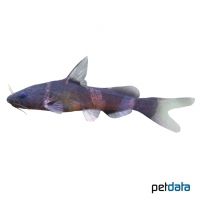Asian Bumblebee Catfish (Pseudomystus siamensis)
| Asian Bumblebee Catfish Pseudomystus siamensis | |
|---|---|
| Name | Asian Bumblebee Catfish |
| Name Lat. | Pseudomystus siamensis |
| Synonym | Liocassis siamensis |
| Family | Bagrid Catfishes |
| Family lat. | Bagridae |
| Order | Catfishes |
| Order lat. | Siluriformes |
| Origin | Thailand, Cambodia |
| Habitat | Streams, tributaries |
| Diet | Carnivore |
| pH | 5.8-7.8 |
| Behavior | Predatory |
| Keeping | Individual |
| Care Level | Moderate |
| Reproduction | Substrate spawner |
| Breeding | None reported |
| Life Span | N/A |
| Protection | No |
| Metric Units | |
| Size | 15 cm |
| Temperature | 20-26 °C |
| Hardness | 4-25 °dH |
| Aquarium | ~ 350 l |
| US Units | |
| Size | 6" |
| Temperature | 68-79 °F |
| Hardness | 71-445 ppm |
| Aquarium | ~ 90 gal |
Distribution and habitat
The distribution area of the nocturnal Asian Bumblebee Catfish is the river system of the lower Mekong in Thailand, Laos, Cambodia and Vietnam and the Chao Phraya in Thailand. They live in slow-flowing streams and tributaries, where they spend the daytime hidden in caves, under roots, stones and branches.
Maintenance
The aquarium should have dense planting in places, with plenty of hiding places, such as stones (e.g. perforated rocks), catfish tubes and roots, and provide adequate swimming space. A dark sandy substrate covered with some foliage (sea almond tree, oak), subdued light (floating plant cover) and slightly acidic water with a weak current is ideal.
No ammonia, ammonium and nitrite should be detectable, the nitrate value should not exceed 100 mg/l. To ensure the water quality and oxygen content, a filter and heater adapted to the aquarium size is required, as well as lighting for the species-appropriate day-night rhythm of the animals.
Diet
In the wild they feed mainly on small crustaceans and insect larvae. The food supply consists of live, frozen and dry food. For a balanced diet, feed once a day with a high-quality sinking dry food for catfish (flakes, granules, pellets) as well as cyclops, daphnia, mosquito larvae, artemia and tubifex (live or frozen)
They are nocturnal fish and should be fed only in the evening. Only feed as much as will be eaten overnight. Regular and varied feeding promotes health and prevents deficiency symptoms
Behaviour and compatibility
They are territorial, predatory solitary animals. Several Asian Bumblebee Catfish can only be kept together in a much larger and richly structured tank. Socialization with larger and robust fish, except bottom-oriented fish, is possible. Fish that are too small are considered prey. Basically, only compatible fish species with similar demands on water condition and water temperature may be socialized
Sex dimorphism
The sexes are difficult to distinguish. The marbling of the males is more contrasting and the females appear rounder. With some experience, the sexes can be distinguished by their genital papilla, which is longer in the male.
Reproduction and breeding
There are no known reports of successful breeding in the aquarium. They spawn at the beginning of the rainy season and the male guards the brood
Important
During the day they usually stay hidden under roots, rocks and foliage, but sometimes come out of hiding during the day in darkened aquariums
The foliage (sea almond tree, oak, etc.) enriches the water with humic substances and naturally lowers the pH value.
When catching, use the finest mesh nets possible to avoid snagging the hard rays of the pectoral fins, which can cause painful injuries when touched.
The well-being of the fish should be checked regularly. Temperature should be checked daily, pH, hardness and nitrate levels at least every 14 days. Regular partial water changes are recommended, even when contaminant levels have not yet reached the upper limit. Sudden changes in water quality should be avoided. Newly introduced fish must be accustomed slowly to the water in the aquarium.
Further literature can be found in your pet store.
References
Text: Werner Winter; Image: petdata
Source: BMEL (1998): Tierschutzgutachten - Haltung von Zierfischen (Süßwasser); BAENSCH & RIEHL (2004): Aquarien Atlas Bd. 2, Mergus Verlag; ENGELMANN (2005): Zootierhaltung - Tiere in menschlicher Obhut: Fische, Verlag Harri Deutsch
- Gemäß § 21 Abs. 5 Tierschutzgesetz idgF
